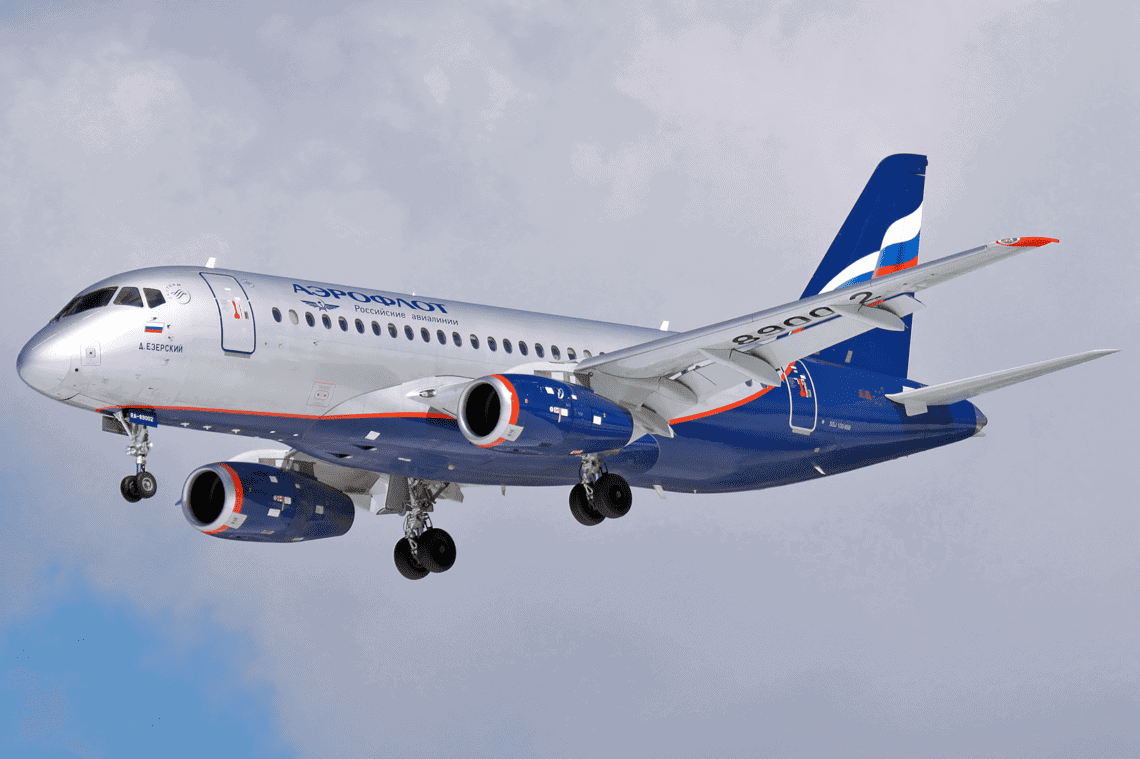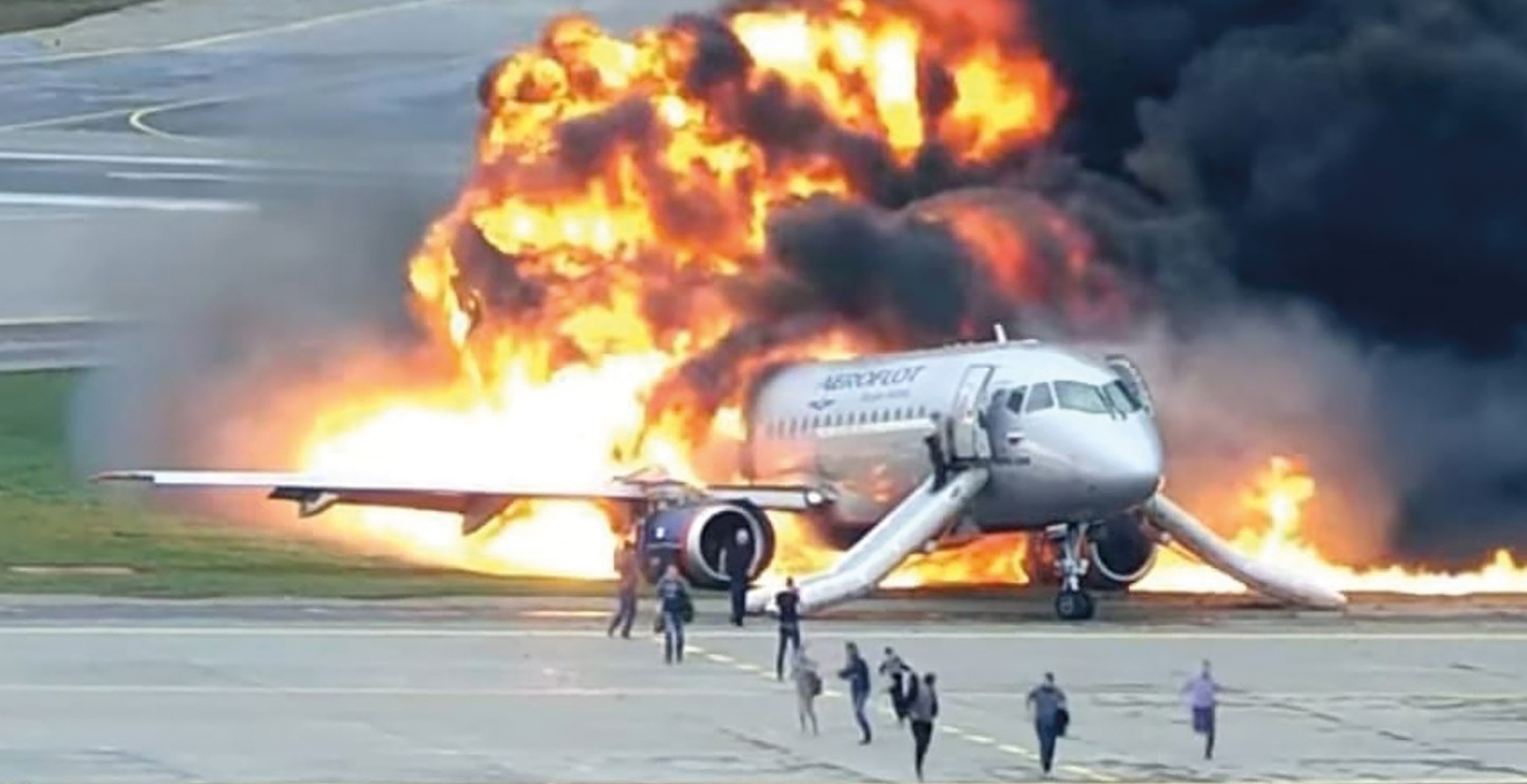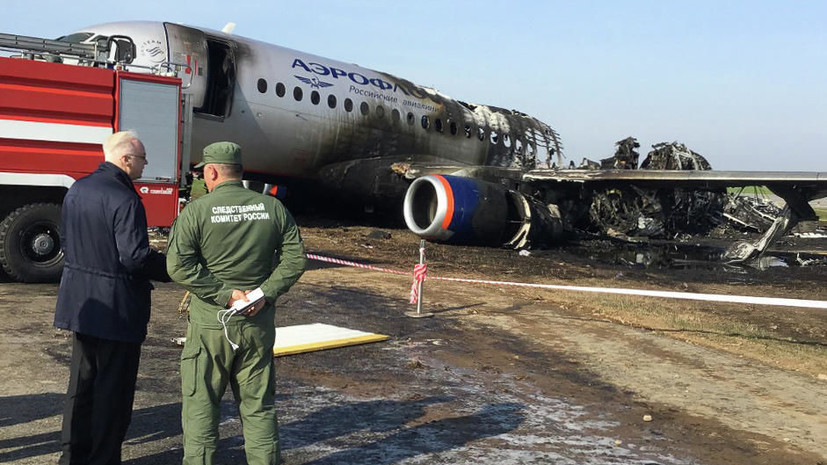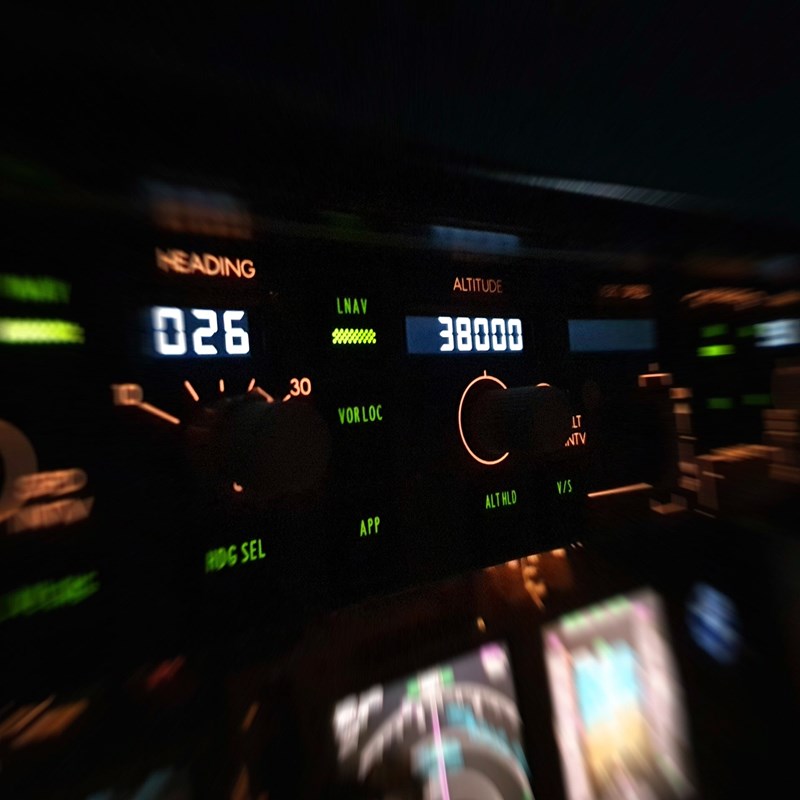05 May 2019 - Aeroflot 1492
Aeroflot Flight 1492 was a scheduled passenger flight from Moscow–Sheremetyevo to Murmansk, Russia. On 5 May 2019, the Sukhoi Superjet 100 aircraft operating the flight was climbing out when it was struck by lightning. The aircraft suffered an electrical failure and returned to Sheremetyevo for an emergency landing. It bounced on landing and touched down hard, causing the landing gear to collapse, fuel to spill out of the wings, and a fire to erupt. The fire engulfed the rear of the aircraft, killing 41 of the 78 occupants.

Accident
Flight 1492 took off from runway 24C at Sheremetyevo International Airport, bound for Murmansk Airport, on 5 May 2019 at 18:03 local time (15:03 UTC). Towering cumulonimbus (thunderstorm) clouds were observed in the vicinity of the airport with a base of 6,000 ft (1,800 m) and peaking at about 29,000 feet (8,800 m). The clouds were moving in a north-easterly direction at a speed of 40–45 kilometres per hour (22–24 kn). When the plane was approaching the thunderstorm zone, a 327-degree heading was selected manually at 18:07 local time (15:07 UTC), initiating a right turn earlier than it is prescribed by the КN 24Е standard instrument departure, but the crew did not request active thunderstorm area avoidance clearance. At 15:08 UTC, the aircraft was climbing through flight level 89 when it was struck by lightning. The primary radio and autopilot became inoperative and the flight control mode changed to DIRECT – a degraded, more challenging mode of operation. The captain assumed manual control of the aircraft. The transponder code was changed to 7600 (to indicate radio failure) at 15:09 UTC and subsequently to 7700 (emergency) at 15:26 UTC while on final approach. The secondary radio (VHF2) remained operative and the crew were able to restore communication with air traffic control (ATC) and made a pan-pan call on the emergency frequency.
The aircraft stopped its climb at flight level 106 and was guided towards Sheremetyevo by ATC. It performed a right orbit before lining up for approach to runway 24L; the crew tuned into the instrument landing system and the captain flew the approach manually. Upon capturing the glideslope, the aircraft's weight was 43.5 tonnes (96,000 lb), 1.6 tonnes (3,500 lb) over the maximum landing weight. At 15:18:53 UTC, the captain attempted to contact the controller to request a holding area, but his message was not recorded by the controller's recorder. The flaps were lowered to 25 degrees, which is the recommended setting for an overweight landing in DIRECT mode. The wind was blowing from 190 degrees at 30 knots (15 m/s) – a 50-degree crosswind – and the speed stabilised at 155 knots (287 km/h). Between 1,100 feet (340 m) and 900 feet (270 m) AGL, the predictive windshear warning sounded repeatedly: "GO-AROUND, WINDSHEAR AHEAD". The crew did not acknowledge this warning on tape. Descending through 260 feet (79 m), the aircraft began to deviate below the glideslope and the "GLIDESLOPE" aural alert sounded. The captain called "advisory" and increased engine thrust, and the speed rose through 164 knots (304 km/h) at 40 feet (12 m) to 170 knots (310 km/h) at 16 feet (4.9 m) AGL – 15 knots (28 km/h) above the required approach speed, although the airline's own Flight Operations Manual provides pilots with a margin of −5 to +20 kt as a criterion for stabilised approach. As he reduced the thrust to idle for the flare, the captain made several large, alternating sidestick inputs, causing the pitch to vary between +6 and −2 degrees.
The aircraft made simultaneous ground contact with all three landing gear legs 900 metres (3,000 ft) beyond the runway threshold at a speed of 158 knots (293 km/h), resulting in a vertical acceleration of 2.55 g. Concurrently with the touchdown, in the span of 0.4 seconds, the sidestick was moved from full aft to full forward. Though the spoilers were armed, automatic spoiler deployment is inhibited in DIRECT mode and they were not extended manually. The aircraft bounced to a height of 6 feet (1.8 m). The captain attempted to apply maximum reverse thrust while he continued to hold the sidestick in the fully forward position. Reverse thrust and reverser door deployment is inhibited in the absence of weight on the aircraft's wheels (i.e. in flight) and the reverser doors only began to open upon the second touchdown. The aircraft lifted off the ground before the reverse door cycle was completed and reverse thrust did not activate. The second touchdown occurred two seconds after the first, nose-first, at a speed of 155 knots (287 km/h) and with a vertical load of 5.85 g. The main landing gear weak links sheared – the weak links are designed to shear under heavy load to minimise damage to the wing – allowing the gear legs to "move up and backwards" and the wing remained intact. The aircraft bounced to a height of 15–18 feet (4.6–5.5 m). The thrust levers were advanced to take-off power – the reverser doors began to close – and the sidestick was pulled full aft in a possible attempt to go around. Thrust was not allowed to increase until the reverser doors were closed and a third impact was recorded at a speed of 140 knots (260 km/h) and with a vertical load in excess of 5 g. The landing gear collapsed, penetrating the wing, and fuel spilled out of the wing tanks. A fire erupted, engulfing the wings, rear fuselage and empennage. Fire alarms sounded in the cockpit for the aft cargo hold and the auxiliary power unit. The aircraft slid down the runway, veered to the left and came to a standstill on the grass between two runway-adjoining taxiways with the nose facing upwind at 15:30 UTC. Power to the engines was cut at 15:31 UTC. Flight recorder data suggest that control over the engines had been lost after the final impact.
An evacuation was carried out from the front passenger doors and their slides were deployed. The first officer used the escape rope to climb out of a cockpit window. Aeroflot claimed the evacuation took 55 seconds, though video evidence shows the slides still in use 70 seconds after their deployment. Passengers were seen carrying hand luggage out of the aircraft. The rear half of the aircraft was destroyed by the fire, which was extinguished about 45 minutes after landing.

Criminal proceedings
A criminal investigation was opened into a fatal "violation of the rules of safe movement and exploitation of air transport". The Investigative Committee said on 6 May it was considering insufficient skill of the pilots, dispatchers and those who performed the technical inspection of the plane, along with mechanical problems and poor weather, as a possible cause of the accident. A high-ranking law enforcement source told Lenta.ru that experts would examine the actions of Sheremetyevo's fire and rescue service. The source said air traffic control were late with raising the alarm and fire engines had not left the fire station at the time of the accident. Only two of the six available engines were involved within the first six minutes and they were not filled with foam, which is more effective against a fuel-fed fire than water. Experts will have to answer more than 50 questions.
On 2 October 2019, investigators filed charges against the captain. According to a spokeswoman for the Russian Investigative Committee, his actions "violated the existing regulations and led to the destruction and outbreak of fire". Prosecutors are seeking a seven-year jail term.
DOWNLOAD the full accident report
Below if part of the CVR transcript from the moment of the lighting strike with a FDR overlay
At 15:08:03, the Approach controller instructed the crew to climb to FL 110. When the FO confirmed receiving the instruction, recorded by the CVR, the sound effect lasting for 1.5 seconds, starting from 15:08:09.7, was recorded. Most probably, at this stage, an atmospheric electricity impact affected the aircraft. 3 seconds prior, the FDR started to record the single commands, indicating the engagement of the permanent ignition on the both engines.
At 15:08:11, the crew set new selected altitude of 11008 ft (3355 m) and the new selected vertical speed of 3281 ft/min (16.7 m/s), and the "VERTCIAL SPEED" / "VS" mode was engaged.
At 15:08:11.9, the disengagement of the autopilot occurred, accompanied by the corresponding aural alert and the switching of the automatic flight control system into the "DIRECT MODE" (see Section 1.18.% of the present Report) with the audio alert "DIRECT MODE. DIRECT MODE". After the sound effect, simultaneously with the autopilot disengagement, the emotional exclamation of one of the crew members was recorded: "Wow!". The auto throttle continued to be engaged. The aircraft was in 20° right roll, crossing FL 89 (2700 m) in climb.
Starting from 15:08:12, during 15 seconds, the FDRs incorrectly recorded single commands and the analogue parameters, which are usually recorded via the electronic interface unit, EIU-100. Two single commands and, "EIU1 FAULT" and "EIU2 FAULT", were recorded simultaneously The conducted examinations (Section 1.16.2 of the present Report) have shown that, most probably, at that stage, a reboot of the data concentrator units occurred, which caused the switching of the automatic flight control system into the «DIRECT MODE». According to the "List of special situations for the RRJ-95B aircraft" during the certification this event had been classified as a "complicated situation".
After the switching to the "DIRECT MODE", the "FLAPS ICE" configuration (slats 0°, flaps1°) was engaged automatically.
Starting from 15:08:16, the aircraft control was switched to manual control from the left-hand side pilot station. During a period of approximately 4 seconds, starting from the moment of the autopilot disengagement and until the PIC took over the aircraft control, the right roll decreased to 13°, pitch attitude increased (from 11° to 12°). The PIC's first control input from was affecting the roll channel, the sidestick was declined to 11.7° to the left (which is for more than half of its travel range), after that the sidestick was advanced to 6.8° (which corresponds to the half of its pitch-down travel range). Further sidestick control movements both in the roll and in pitch channels was of an abrupt and intermittent character. At 15:08:22, the aircraft was turned to the right via multiple impulse deflections of the sidestick ranging from 30% to 65%. To set the roll of ≈20° the pilot performed more than 10 roll deflection movements of the sidestick during a period of 18 seconds. Moreover, at different moments of the further flight the PRIORITY / APOFF8 button was pressed momentarily (for approximately 1 second) on the left sidestick 6 times.
At 15:08:47, the auto throttle was disengaged by the overriding movement of the thrust lever. At 15:09:17, the aircraft was put out of the right roll mode and was set to the heading of about 60°.
After short discussion with the FO, the PIC made the decision to return to Sheremetyevo and ordered the FO to report PAN-PAN. After several failed attempts to contact the controller on the working frequency via VHF-Station 1 (the one that was used from the beginning of the flight), at 15:09:32, after a discussion, the crew set the 7600 squawk code (for the lost radio communication).
At 15:09:35 radio-contact was restored at the emergency frequency (121.5 MHz) via VHF Station 2. After that, at 15:09:39, the FO reported the Approach controller: "Moscow-Approach, request return of 14-92, radio lost, aircraft in direct mode". The controller issued an instruction to descend to FL 80. Maximum altitude the aircraft gained was 10600 ft (3230 m) (QNE). The crew responded: "Aeroflot 14-92, heading 0-57, descending to FL 8-0". The controller confirmed the clearance for the descent with the maintained present heading. Further flight until the moment of the glideslope capture was performed by means of vectoring.
At 15:09:52, the crew set the selected altitude of 8000 ft (2438 m) and disengaged the FMS speed control mode, set the selected speed of 250 kt (463 km/h) and put the aircraft into the descent mode. In descending, the PIC maintained the indicated air speed by changing the pitch angle and the thrust levers' positions. Upon each receipt of the controller's instructions, the crew set the new selected altitude (at 15:10:51 it was set to 7008 ft (2136 m), at 15:12:01 –it was set to 5984 ft (1824 m)).
At 15:12:32, the PIC explained to the purser that the aircraft was returning to the airdrome of departure and emphasized: "No emergency, we are simply going back". At 15:12:43, the controller instructed the crew to turn right to the heading of 140° and to descend to FL 900m QFE.
At 15:12:47, the selected heading of 140° was set, and the PIC set the aircraft into the right turn. The turning was performed with the roll, changing within the range of 13° to 22°. In the process of turning, when receiving the corresponding instruction from the controller, the selected heading was set to 160°.
Upon the controller ' request: "Any assistance required?", the crew responded: "No, so far everything is normal, standard". Upon the controller's request for clarification, the crew responded that they were having problems with the radio communication and that the automatic flight control had been lost.
At 15:13:11, the PIC ordered to perform the QRH «F/CTL DIRECT MODE» section. The FO initiated the performance of the QRH «AUTO FLT AP OFF» section two times, because these actions were interrupted by his communication with the controller.
At 15:14:36, the aircraft was put on heading of ≈170°.
At 15:15:05, the controller instructed the crew to turn right to the heading of 180° and to descend to 600 m QFE.
At 15:15:10, the selected heading was set to 181° and at 15:15:27 the selected altitude was set to 2592 ft (790 м)9 and did not change till the end of the record.
At 15:15:34, the controller cleared the crew for the ILS Yankee approach, RWY 24 left. After the permission confirmation, the FO started reading section QRH "F/CTL DIRECT MODE", inter alia: "… Auto throttle should not be used, fly smoothly. … Balance manually. … Speed brake no less than a half. … use Flaps 3. TAWS, landing gear, Flaps 3 on. V approach, V reference plus 10. Landing distance – increase by 1-34. … Speed brake set to full after touchdown. Go-around lever to NTO".
At 15:16:54, the controller instructed: "… proceed right heading 210 till localizer capture …".
At 15:17:39, the FO, after the command from the PIC, reported to the controller that the crew was not ready to perform landing approach and requested an «orbit», but then corrected himself: "the circuit" and the controller responded: "… heading 360 to the right".
At 15:18:53, the PIC tried to contact the controller himself: «Aeroflot 14-92, holding area above Kilo November, if possible». The message was not recorded by the controller's recorder. The PIC did not raise this question again.
When performing an orbit flight at 600 m QFE, the PIC could not maintain the altitude precisely. During right turns with roll up to 40°, the deviation from the selected altitude exceeded ±200 ft (60 m), and that triggered multiple aural alerts. The PIC was aware of that, at 15:22:53: "How come… plus-minus 200 feet".
During the orbit flight performance, the FO was reading out the QRH "OVER MAXIMUM LANDING WEIGHT LANDING". The weight of the aircraft was about 42 600 kg which exceeded the maximum landing weight by 1600 kg. To gain the maximum thrust in order to be able to perform the go-around, the crew switched off the engine air bleed supply to the conditioning system. The FO also read out that the maximum vertical speed of descend before the touchdown must be no more than 360 ft/min (1.8 m/s).
At 15:20:41, the crew started the APU.
At 15:21:38, at 225 kt (415 km/h) the crew initiated the flaps deployment to FLAPS 1 (slats 18°, flaps 3°).
At 15:23:03, after the PIC's order, the FO reported the controller that the crew was ready for landing.
At 15:23:19, at 190 kt (350 km/h) the crew initiated the flaps deployment to FLAPS 2 (slats 24°, flaps 16°).
At 15:23:58 the crew started the landing gear extension.
At 15:24:02, the crew armed the speedbrake system.
Note: Automatic speedbrake deployment mode which can be engaged during the landing and which is inactive when the Remote Control system is in the "DIRECT MODE".
At 15:24:20, at 170 kt (315 km/h), the crew set the flaps into the landing configuration, FLAPS 3 (slats 24°, flaps 25°). During the landing gear and flaps deployment, the PIC performed stabilizer trimming manually. When the aircraft was set to the landing configuration, the stabilizer deflection angle was ≈3.5° pitch-up and it almost did not change until landing (one short pitch-up pressing was recorded during the glideslope descent). The aircraft was put to the landing heading at the distance of more than 20 km from the RWY 24L threshold. The final approach fix is located at the distance of 9.3 km. At 15:24:38, the crew responded to the controller's request that they would perform the ILS Approach.
By 15:25:57, the crew had finished the "DURING LANDING" section checklist. The crew performed neither the before-landing briefing nor the "APPROACH" checklist.
At 15:26:05, the crew had the following conversation: the FO "Should I set the transponder to 7700? Or leave as it is? Ok, roger.". The PIC: "We could have done it long before, actually." The CVR record does not provide us with clear understanding of the PIC's decision. Nevertheless, at 15:26:31 the crew set the transponder to 7700.
At 15:27:20, the glideslope descent was initiated. The go-around altitude was not set by the crew. The descent was performed at the indicated air speed of 155…160 kt (287...296 km/h) parallel to (lower) the prescribed glideslope. The heading deviation did not exceed 0.5 dot. The elevator followed the pitch commands from the sidestick, which was regularly declined by the PIC in for the pitch-up by 2…3° (i.e. for 15…20% of its travel range). When the sidestick was released and returned to its neutral position, the pitch was tending to decrease: thus, the aircraft was balanced (trimmed) by the pilot via residual backward pressure. The thrust levers positions were changing within the range of 11° to 20.5°, the engine N1 was changing within the range of 43% to 69%. The wind at the glideslope was up to 30 kt (15 m/s), 190° to 200°. The crab angle was up to ~8°.
At 15:27:51, the controller provided the crew with the meteorological information and cleared for landing: "Aeroflot 14-92 wind at the ground 160 degrees 7, gusts 10 meters per second, runway 24 left, landing cleared for". The crew confirmed the landing clearance.
At 15:28:26, at 1600 ft (490 m) QNH (at the radio altitude of 1100 ft (335 m)) the "WINDSHEAR" warning was recorded, it is generated by the crew alerting system based on the wind shear forecast data of the weather radar, accompanied by the voice message "GO-AROUND, WINDSHEAR AHEAD". This warning informs the crew about the possible wind shear enroute. The alert lasted for 11 seconds and included 2.5 warning cycles (5 voice messages, each cycle consisting of 2 messages one after another, with the 1 second interval in-between). The crew had no discussion of this warning triggering.
Note: In the QRH «W/S AHEAD» Section (1.18.8) states that the triggering of this warning during the approach indicates that the crew must initiate the go-around procedure. At the same time in the beginning of the section, there is the notice that if the crew is sure that there is no wind shear hazard and there are no other signs of wind shear, and the RWS is operative, this warning may require no responsive actions from the crew. The same provisions are incorporated into the Flight Operations Manual. In 0.5 second, the voice message informed the crew that the aircraft had reached the height of 1000 ft (305 m). The PIC decided to continue the approach and informed the FO on it by saying: "Proceed", the FO responded: "Check".
At 15:29:22, the FO called out that the landing decision height was close. The PIC confirmed continuing the approach.
At 15:29:31, at 270 ft (82 m) the aural annunciator system informed the crew on reaching the landing decision height minimum, it was repeated by the FO. Starting from that moment, there was fast increase of the downward glideslope deviation (up to minus 1.4 dots), which caused the TAWS "GLIDESLOPE" alert triggering to indicate the glideslope deviation The alert was on for 4 seconds. The PIC confirmed hearing the alert by saying "Advisory". Simultaneously with the warning triggering, the PIC increased engines power (the trust levers were set to 24° to 23°, which caused the N1 increase up to 77 to 74%). The increase of the engine power caused the increase of the indicated air speed: when the aircraft was passing RWY threshold: at 40 ft (12 m) it was up to 164 kt (304 km/h), and by 16 ft (5 m) it was up to 170 kt (315 km/h).
According to FCOM, the required landing approach speed for the actual conditions was 155 kt (287 km/h). This speed was set by the crew as the selected speed. The airline's Flight Operations Manual contains the value plus 20 kt as the criterion for the stabilized landing approach. Over the RWY threshold, the glideslope deviation was minus 0.9 dot (i.e. below the glideslope). After passing the RWY threshold, the vertical speed of descent was decreased.
At 15:29:54, at 17 ft (5.2 m) aural alert "RETARD. RETARD" informed the crew on reaching the height recommended for the thrust levers to be set to "IDLE" during the flare. The PIC started to change thrust levers positions simultaneously with the alert triggering. Almost simultaneously with the thrust levers positions changed to "IDLE", the PIC initiated the flare by pulling the sidestick by 8.8° (65% of its travel range). Further on, the PIC's ever amplitude increasing pitch sidestick inputs were recorded up to the both maximum advanced and maximum retarded positions with a relatively long holding period in the both maximum positions. These inputs caused counter-reversal pitch change (+6…-2º). At 15:30:00, at a distance of ≈900 m from the RWY threshold at indicated air speed of 158 kt (293 km/h), first touchdown occurred. The touchdown occurred at the pitch angle close to zero ( 7 pitch up rate; at the moment of the touchdown, the sidestick was in the maximum retarded position; and during the landing within 0.4 seconds, its position was changed for the maximum advanced), for "threedots", with vertical g-force of no less than 2.55 g.
After the aircraft bounced up, the sidestick continued to be held in the maximum advanced position, which caused the pitch downward rate of up to 10.5°/s, the rapid downward pitch angle decrease to 4° and the repeated touchdown with the nose landing gear touching the ground first. The second touchdown occurred 2.2 seconds after the first touchdown, at the indicated air speed of 155 kt (287 km/h).
Landing performed with the nose gear touching the ground first, with the high vertical speed and the fully retarded sidestick immediately before touchdown, caused the intensive pitch-up rotation of the aircraft. The maximum pitch rate recorded was ≈25°/s and the vertical g-force was no less than 5.85 g. As the result, the angle of attack and the pitch angle increased, which, due to the remaining significant value of the indicated air speed, caused the repeated bouncing ("progressing bouncing"), despite the sidestick fully advanced position at bouncing up. During the first bouncing up, when the aircraft was in the air, the PIC switched the thrust levers to the "Maximum Reverse" mode but the thrust reverser doors did not deploy, as there were no weight-on-wheel (WOW) signals. Upon receipt of the left and right main landing gears WOW signals, the reverser doors started to deploy, which was completed after the second aircraft bouncing up movement off the RWY. There was no engine power increase as at this moment, there was no WOW signals again.
During the second bouncing up, the aircraft reached the height of ≈ 15 - 18 ft (5-6 m). In 2- 3 seconds after this repeated bouncing up, the thrust levers were set to "Takeoff" mode and the sidestick was pulled to the maximum retard position. These actions may be interpreted as an attempt to perform the go-around, as before that the thrust reverser system was engaged (the reverser doors were in the open position, though starting to close), the engine thrust did not increase.
At 15:30:05, with the indicated air speed of 140 kt (258 km/h), the third touchdown occurred with vertical g-force of no less than 5 g. The type of the markings, left on the RWY after the third touchdown, indicate that the main landing gears were by that moment already partially destroyed. The main landing gears collapsed, further on, the aircraft structural disintegration with fuel spillage and fire occurred.
After the third touchdown, the flight data recorders recorded the information which indicates the possible loss of the engines' control (full or partial). In order to analyse this issue, the investigation team is planning to examine the DECU. The engines were operating until the end of the record.
At 15:30:15, the thrust levers were repeatedly switched to the "MAXIMUM REVERSE". The ground speed at that moment was 107 kt (198 km/h). This action did not cause any changes, the engines continued to operate in the "IDLE" mode, the reverser doors were in the transit positions.
At 15:30:18, "Aft cargo compartment fire" event was recorded. The aircraft ground speed was ≈ 100 kt (185 km/h). Note: In fact, taking into consideration the type of the sensors, the alert indicates the smoke detection, not fire detection.
At 15:30:24, the CVR recorded the controller's command: "Emergency service to the runway".
At 15:30:30 and at 15:30:34, the flight attendants' reporting’s of fire were recorded.
At 15:30:34, the "APU fire" event was recorded. The aircraft ground speed 25 kt (46 km/h).
At 15:30:38, the aircraft stopped its movement. Immediately before that, the aircraft turned left, nose upwind. At the same time, the two call-outs of the flight crew addressing the cabin crew were recorded: "Attention crew! On station. Attention crew! On station"
At 15:30:44, the PIC called out: "Emergency evacuation checklist".
The CVR did not record the checklist performance.
At 15:30:49, the flight attendants' command was recorded: "Undo the seatbelts, leave everything, evacuate…"
At 15:30:52, the PIC called out: "Evacuation".
At 15:30:53.3, the CVR stopped recording.
At 15:30:58, "APU fire extinguisher discharged" event was recorded, however, no event of the fire extinguisher bottle discharge input was not recorded.
At 15:31:06, FDR stopped recording.
At about 15:31:34, according to the sound data of the video record, engines' shutdown occurred.


